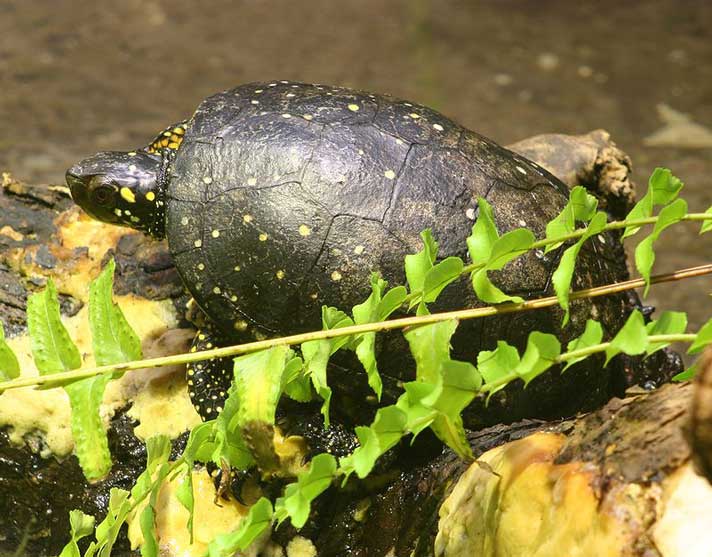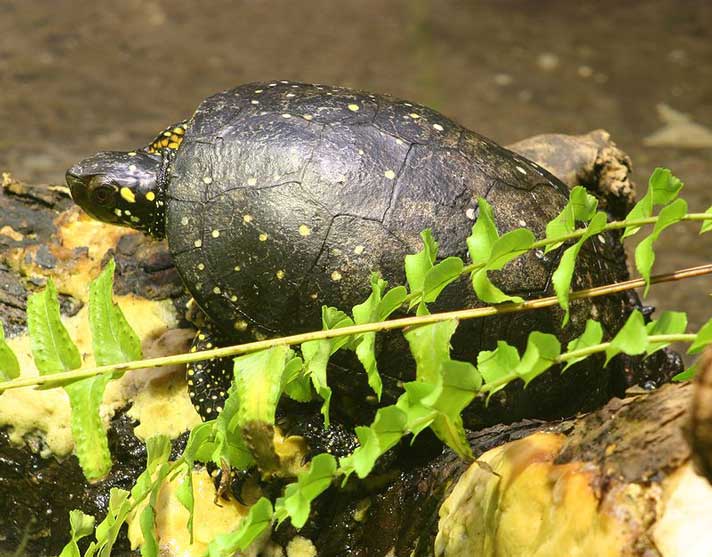The attractive spotted turtle has serious conservation needs.
Spotted turtles (Clemmys guttata) are one of our smallest and also one of the most attractive of our North American turtles. Only rarely will an adult reach 5 inches in length. They live in various shallow water wetlands ranging along the Atlantic slope from New England to Central Florida, and throughout much of the Great Lakes region. Isolated populations occur in southeastern Canada. Their size, behavior and coloration make them desirable to the pet trade. They are easy to maintain and to breed in captivity. In fact, I am currently into my fourth generation of captive bred spotted turtles.

Dave Pape/Wikipedia
Spotted turtles (Clemmys guttata) are one of our smallest and also one of the most attractive of our North American turtles.
The dilemma is that throughout their entire range they are a species of conservation concern. Over the years draining of wet lands, increased traffic on rural roads and poaching for a growing commercial pet trade has all taken its toll on these once common little turtles. Hobbyist wishing to work with this species should not remove them from the wild and need to acquire captive-bred turtles only from responsible sources.
This is a turtle of the spring. Throughout the core of their range 70 to 90 percent of their annual activity occurs between March and May. They live in a variety of wetland habitats. These habitats share the characteristics of shallow water, emergent vegetation and open shade. Sexing adult turtles is simple; you can do it from either end. Females have orange or reddish chins and small tails; males have dark pigmented chins and thick long tails.
Spotted Turtle Housing
Like most species of temperate climate turtles, spotted turtles do best when maintained in outdoor enclosures. Because of the extended north to south axis over which spotted turtles occur, captives are pre-adapted to almost any climate zone in North America and are the perfect species to keep outdoors. They may go dormant in the summer and hibernate for long periods, just feed them generously during the periods when they are active. Outdoor enclosures provide natural light, fluctuations in climate, additional space, and large and pleasing habitats for your captives. In turn they respond by having better health than ones maintained indoors and exhibit natural reproductive cycles. A partly shaded enclosure with series of pools of various sizes and depths is the dream home of captive spotted turtles. These pools should contain aquatic vegetation and be interspersed with wet boggy soils and high ground. In such setups they do well and can be kept with similar-sized native North American species. I keep mine with box, wood, Pacific pond, and chicken turtles.
Weathered log, live sphagnum moss, ferns and other plantings can make the enclosures quite attractive. Ideal captive groups will be composed of a male and three to four females, with larger groups you should strive for a similar sex ratio.
Spotted turtles can be kept inside if you must and maintained with standard lighting, basking spots and filtration, but probably keeping pet rocks is simpler and almost as interesting. Keep in mind that the behavior and curiosity of spotted turtles will not be fully appreciated in a rubber, water-filled tub.
Feeding Spotted Turtles
Spotted turtles are easy to feed; from hatchling stages to adults they do well on commercially available pellets. This food can be supplemented with crickets, worms, fish and similar protein sources. Turtles maintained outside will forage on aquatic insect larvae, tadpoles and other aquatic organisms that find their way into your outdoor set ups. Feed turtles sparingly in the early spring and fall as under cool temperatures they have trouble digesting food, and accumulations of undigested food in their stomachs can ferment and kill hibernating turtles. Unlike wild spotted turtles, those maintained in captivity often remain active and feed throughout the summer months. With longer periods of activity and with quality diets they typically double clutch each year.
Breeding Spotted Turtles in Captivity
Both in the wild and in captivity spotted turtles emerge early in the spring, I have seen them sunning in March afternoons when it was snowing. Their dark shells absorb heat quickly allowing the turtles to go about their business. And in the spring their business in mating. In the southern and mid-Atlantic states eggs are laid in late May and early June, but more northern populations lay through July. Females typically produce three to five eggs per clutch and captives often lay two clutches per year. By late June adults in the wild are difficult to find as they spend much of the remaining year dug into damp soil, rarely emerging till the following spring.
The incubation of spotted turtle eggs (and those of related species and genera) is simple and straight-forward. Place them in a moist (not damp or wet) medium and let them incubate naturally. I keep mine in an unused refrigerator in a shady spot. The refrigerator protects them from ants and larger predators, retains a high humidity, but allows some fluctuation in daily and seasonal temperature. I have also successfully hatched their eggs in plastic shoe boxes placed on a shaded shelf on a screen porch. Like most North American turtles incubation is not a tricky process. I find that spotted turtle eggs maintained under fluctuating temperatures do far better than those under constant temperatures set in commercial incubators. During the first few weeks when the sex of the embryos is established high temperatures in the low 80s work best and provide a mix of males and females. Constant temperatures below 70 degree Fahrenheit above 90 degrees result in egg mortality or deformed young, but brief drops and spikes into these ranges is not a real problem. Artificially incubated eggs typically hatch in two to three months depending on temperature. In outdoor pens where you might not find all the eggs look for young in August and September and again in the spring as some young over-winter in their nests.
It is probably wise to keep hatchlings and yearling inside for their first 18 months or so. Once they are about two inches they can be moved in the late spring to outside quarters, and even kept with their parents. The hatchlings are vulnerable to predators (birds and large frogs find their way into the best of protected outdoor pens). Inside they can be fed through their first or first and second winters, accelerating their growth during what would otherwise be their hibernation period. I keep pieces of cypress logs with my hatchling as they shift the water pH and help control fungus.
Ethical Considerations Come First When Acquiring a Spotted Turtle
Like many other turtles spotted turtles are long lived and in most places within their range they exist in low densities in small isolated wetlands. I have a friend studying this species and through a long-term, mark-recapture study she has shown that over 57 percent of the turtles at their study site are 50 years of age or greater, and some individuals are known to exceed 100 years of age. Removing spotted turtles from the wild is beneath unethical. Every spring large numbers of spotted turtles appear for sale on the Internet. The sellers claim the turtles are from Florida (about the only state where they naturally occur where they are not protected; yet their total populations there is extremely small and they live is very restricted areas) or they are marketed at captive bred animals. Photos show the turtles for sale to be adults, and often they are said to be gravid. They probably are because by the time they get from the collectors to the dealers its late spring and they are ready to lay eggs. One spring I saw photos of marked (notched) adults that were obviously collected from some ones study site. Please do not purchase wild-caught turtles, and if you suspect they might be wild caught they probably are. Nearly all wild-caught and adult spotted turtles for sale are the result of illegal capture, possession and transport. By the time you see them for sale the people marketing them have broken any number of state and federal wildlife and commerce laws. Dealers selling adult spotted turtles are suspect, and one can assume that many of the other species appearing on their inventory are illegal as well. Become an informed and ethical buyer when it comes to wildlife purchases.
The good news is that there are lots of people breeding spotted turtles and hatchlings are readily available. They grow quickly and in captivity, with a good diet, they can reach adulthood in only five years. In that hatchlings are nearly impossible to find in the wild, but you cannot be assured that anyone with a number of hatchling spotted turtles is captive breeding them. Young on the market are often the result of eggs obtained from wild caught females. Do your homework, know who is selling you your turtles. It’s important.


